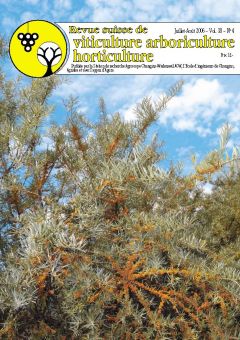
Issue 4 - July - August 2006
Abstract in open access
The pulp of sea buckthorn fruits is very rich in various antioxydant agents. Médiplant evaluated various lineages of sea buckthorn in order to select the origins best suited to cosmetic use. Considerable differences in the composition of the fruit pulp were noted between the alpine and oriental origins. The alpine origins, richer in antioxydant agents and poorer in fatty substance, were retained by the cosmetics industry. A followup of the berries maturity showed a maximal vitamin C content at the very beginning of fruit colouring. However the flavonoids and fruit acids contents remained stable during the whole maturation period.
Keywords: sea buckthorn, Hippophaë rhamnoides, cosmetic, organic acids, flavonoids, vitamin C, alpine origins
E-Mail: melanie.quennoz@acw.admin.ch
Adress:
Abstract in open access
Médiplant has evaluated various rose bushes species for the biological production of fat matter extracted from the seeds. Two species, Rosa rugosa and R. rubiginosa, stood out for the quality and productivity aspects. R. rugosa showed itself particularly easy to cultivate, to maintain and to harvest. For this species, the average seeds yield is 180 g per plant, with fatty substance content above 15%. The fatty substance content remained stable throughout the 10 years culture; at the contrary the seeds yield fluctuated considerably.
Keywords: Rosa rugosa, Rosa rubiginosa, seed oil, culture, yield
E-Mail: melanie.quennoz@acw.admin.ch
Adress:
Abstract in open access
Today’s mastery of the impact of oak wood on barreled wines depends on a detailed knowledge of the «terroir» from which it arises. In any forest, a terroir results from a complex and original interaction of several characteristics such as climate, soil, botanical species and history. The certified channel of cooperage wood «Terroir Chêne» is aimed at feeding a top-range craft industry and at preserving a threatened natural and cultural heritage.
Keywords: Quercus robur, Quercus petraea, Quercus pubescens, oak wood, terroir, barrels, wines, channel, Swiss forestry
E-Mail: denis.horisberger@vd.ch
Adress:
Abstract in open access
An experimental plot located in Perroy (Vaud, Switzerland) has been conducted from 1998 to 2004 partly according to the principles of the integrated production (IP) and partly as organic production (Bio). Globally the control of the fungal diseases led to satisfactory results in both systems. Under high powdery mildew pressure, the Bio products were less efficient. The Bio products have decreased the predatory mites Typhlodromus pyri populations, without compromising the biological control of mites. In Bio, the more important number of sprays related to the man work has increased the costs of the disease control of about 40% compared to IP. No significant differences could be obtained on the nutritional aspects of the plants. The soil management practices in Bio allowed a good management of the nitrogen status of the plant. Among the major elements, only the potassium in Bio has been weakly absorbed by the plants. The weight of the berries at harvest was lighter in Bio during the dry years. Analysis performed on the must did not show noticeable differences.
Keywords: integrated grape production, organic grape production, plant protection, nutrition, production costs
E-Mail: christian.linder@agroscope.admin.ch
Adress:
Abstract in open access
Eight redcurrant varieties were tested from 1994 to 2003 at the Agroscope Changins-Wädenswil experimental estate in Bruson (Wallis, Switzerland). Important differences between varieties were highlighted regarding the placement of the clusters along the twigs. These specificities mean that pruning has to be suited to the variety in order to ensure or improve the quality of the clusters, the yield and the picking speed.
Keywords: redcurrant, quality, ribes, variety trial, yield
E-Mail: roger.carron@acw.admin.ch
Adress:
Abstract in open access
Acids are often used in to adjust pH levels. They are very efficient, but represent a security hazard through handling. To minimize this risk, a liquid solution of ammonium nitrate was tested to adjust the nourishing solution (with recycling process). Two ratio levels of N-NH4 + and N-NO3 - were compared. The achieved yield with a high ratio is slightly higher to those with a low ratio and to those achieved in a standard green-house (pH adjusted with nitric acid). The quality of fruits of the high ratio and the standard green-house proceedings (sugar content, acidity and firmness) is pretty similar and better than that of the lower ratio.
Keywords: soilless culture, ammonium nitrate, tomato, acid, pH
E-Mail: pascal.sigg@acw.admin.ch
Adress:

 Download of full issue
Download of full issue
 Download article
Download article